Researchers at Washington State University are working on graphene-based sodium-ion batteries that might provide a less expensive, viable alternative to lithium-ion batteries.

The researchers used tin oxide nanocrystals supported on a graphene structure to vastly improve the battery. The team explained that technology also could be used in lithium-ion batteries, making it more attractive for manufacturing.
Using tin oxide in a battery’s anode gives it the potential to store almost three times the energy of graphite that is typically used in batteries, and it’s easy to make. However, tin oxide wears out quickly and stops working. In their study, the researchers were able to solve the degradation problem by making ultrafine nanocrystals of tin dioxide that were tightly bound to a three-dimensional graphene structure. Their hybrid structure was reportedly robust, well connected and porous, allowing for better transport of electrons and ions.
Their research shows that the material greatly improved the charging capacity and rate of both types of batteries, and the hybrid material exhibited outstanding electrochemical performance, according to the team. The researchers also tested the materials in a full battery.
The researchers also worked with scientists at the Department of Energy’s Pacific Northwest National Laboratory, who provided expertise on cathode materials. The research was funded by Washington State University.

